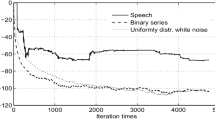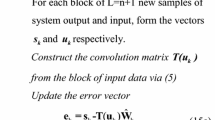Abstract
This paper develops a new blind channel identification method in frequency domain. Oversampled signal has the property of spectral redundancy in frequency domain which is corresponding to the cyclostationarity property in time domain. This method exploits the cyclostationarity of oversampled signals to identify possibly non-minimum phase FIR channels. Unlike many existing methods, this method doesn’t need EVD or SVD of correlation matrix. Several polynomials are constructed and zeros of channels are identified through seeking for common zeros of those polynomials. It is in the similar spirit of Tong’s frequency approach, but this new algorithm is much simpler and computationally more efficient. A sufficient and necessary condition for channel identification is also provided in this paper. This condition is quite similar to Tong’s time domain theory but it is derived from a novel point of view.
Preview
Unable to display preview. Download preview PDF.
Similar content being viewed by others
References
Xie, S.L., He, Z.S., Fu, Y.L.: A Note on Stone’s Conjecture of Blind Separation. Neural Computation 17, 245–319 (2005)
Li, Y.Q., Amari, S., Cichocki, A.: Probability Estimation for Recoverability Analysis of Blind Source Separation Based on Sparse Representation. IEEE Trans. Inform. Theory 52, 3139–3152 (2006)
He, Z.S., Xie, S.L., Fu, Y.L.: A Novel Framework of Multi-channel Acoustic Echo Cancellation. Progress in Natural Science 16, 983–987 (2006)
Li, Y.Q., Amari, S., Cichocki, A., Ho, D.W.C., Xie, S.L.: Underdetermined Blind Source Separation Based on Sparse Representation. IEEE Trans. Signal Processing 54, 423–437 (2006)
He, Z.S., Xie, S.L., Fu, Y.L.: Sparse Representation and Blind Source Separation of Ill-posed Mixtures. Science in China Series F-Information Sciences 49, 639–652 (2006)
Li, Y.Q., Cichocki, A., Amari, S.: Blind Estimation of Channel Parameters and Source Components for EEG Signals: A Sparse Factorization Approach. IEEE Trans. Neural Networks 17, 419–431 (2006)
Godard, D.N.: Self-recovering Equalization and Carrier Tracking in Two Dimensional Data Communication Systems. IEEE Trans. Commun. 28, 1867–1875 (1980)
Shalvi, O., Weinstein, E.: New Criteria for Blind Deconvolution of Nonminimum Phase Systems (Channels). IEEE Trans. Inform. Theory 36, 312–321 (1990)
Xie, S.L., He, Z.S., Gao, Y.: Adaptive Theory of Signal Processing, 1st edn., pp. 103–129. Chinese Science Press, Beijing (2006)
Gardner, W.: A New Method of Channel Identification. IEEE Trans. Commun. 39, 813–817 (1991)
Tong, L., Xu, G., Kailath, T.: Blind Identification and Equalization Based on Second-Order Statistics: A Time Domain Approach. IEEE Trans. Inform. Theory 40, 340–349 (1994)
Moulines, E., Duhamel, P., Cardoso, J., Mayrargue, S.: Subspace Methods for the Blind Identification of Multichannel FIR filters. IEEE Trans. Signal Processing 43, 516–525 (1995)
Roberto, L., Soura, D.: Blind Channel Equalization with Colored Sources Based on Second-Order Statistics: A Linear Prediction Approach. IEEE Trans. Signal Processing 49, 2050–2059 (2006)
Li, X., Fan, H.: QR Factorization Based Blind Channel Identification and Equalization with Second-Order Statistics. IEEE Trans. Signal Processing 48, 60–69 (2000)
Long, L., Xu, G., Hassibi, B., Kailath, T.: Blind Channel Identification Based on Second-Order Statistics: A Frequency-Domain Approach. IEEE Trans. Inform. Theory 41, 329–334 (1995)
Author information
Authors and Affiliations
Editor information
Rights and permissions
Copyright information
© 2007 Springer Berlin Heidelberg
About this paper
Cite this paper
Caiyun, C., Ronghua, L. (2007). A New Approach of Blind Channel Identification in Frequency Domain. In: Liu, D., Fei, S., Hou, Z., Zhang, H., Sun, C. (eds) Advances in Neural Networks – ISNN 2007. ISNN 2007. Lecture Notes in Computer Science, vol 4493. Springer, Berlin, Heidelberg. https://doi.org/10.1007/978-3-540-72395-0_81
Download citation
DOI: https://doi.org/10.1007/978-3-540-72395-0_81
Publisher Name: Springer, Berlin, Heidelberg
Print ISBN: 978-3-540-72394-3
Online ISBN: 978-3-540-72395-0
eBook Packages: Computer ScienceComputer Science (R0)




